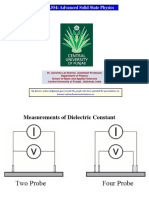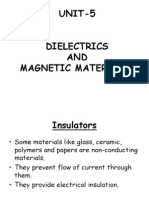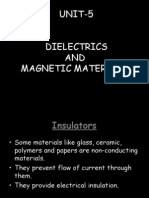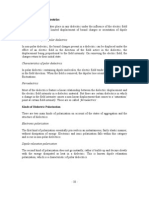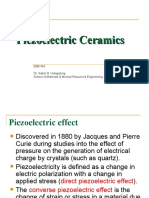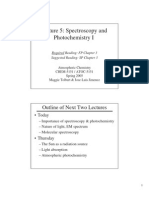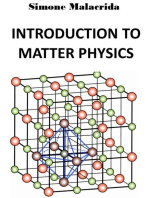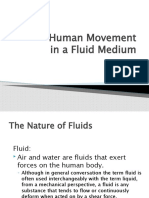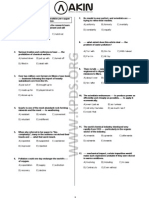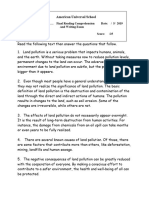Ferro Electrics
Ferro Electrics
Uploaded by
Mohit GaharanaCopyright:
Available Formats
Ferro Electrics
Ferro Electrics
Uploaded by
Mohit GaharanaCopyright
Available Formats
Share this document
Did you find this document useful?
Is this content inappropriate?
Copyright:
Available Formats
Ferro Electrics
Ferro Electrics
Uploaded by
Mohit GaharanaCopyright:
Available Formats
Ferroelectrics
Basic principles
Outline
What is the origin of electrostatic effects
from crystalline materials?
How might one classify ferroelectrics?
A tour of some examples of ferroelectric
materials
An overview
Non-conducting materials may have a net
electrostatic polarisation induced by an
external electric field.
Where the affects upon observable
properties such as elastic, optical and
thermal behaviour is large, these materials
are termed ferroelectrics.
To gain some understanding, well start
with a simple model
A nave picture
Energetics
A nave picture
A nave picture
A nave picture
A nave picture
The local alignment of
dipoles can exist over any
length scale.
Different regions may
exist with different
polarisation orientations:
Call these domains in line
with magnetic materials.
In contrast with magnetism,
domain walls are abrupt.
Applied field
Suppose we now apply an electric field,
horizontal in the figure.
If it is of sufficient strength, the small ions
will be able to overcome the barrier and
dipoles will switch direction
The dipoles are polarised by the applied field.
Domain walls move.
Polarisation vs. E-field
Suppose we start with a material where
there are many domains which are
aligned randomly.
What is the initial polarisation?
Polarisation vs. E-field
If we apply a small electric field, such that it is
not able to switch domain alignments, then the
material will behave as a normal dielectric:
PE
As E is increased, we start to flip domains and
rapidly increase P.
When all domains are switched, we reach
saturation.
What happens if the E-field is now removed?
Polarisation vs. E-field
The value at zero field is termed the remnant
polarisation.
The value of P extrapolated back from the
saturation limit is the spontaneous
polarisation.
Reversal of the field will eventually remove all
polarisation
The field required is the coercive field.
Further increasing the reverse field will
completely reverse the polarisation, and so a
hysteresis loop is formed
Polarisation hysteresis
P
E
Polarisation hysteresis
P
E
Polarisation hysteresis
The essential feature of a ferroelectric is
not that there is a spontaneous
polarisation, but that the spontaneous
polarisation can be reversed by the
application of an electric field.
E
Now, E is small enough for the applied
field to reverse the direction of the dipoles,
i.e. move the atoms within the crystal,
what else might affect this change?
What are the relative sized of E and k
B
T?
What will happen if Ek
B
T?
Curie temperature
Above a critical temperature
the spontaneous polarisation
will be lost due to one of two
effects:
A change of structure such that
there is a single minimum in the
energy mid-way between sites
The rate that the small ions hop is
so high that on average there is
no net polarisation
Curie temperature
This temperature is termed the Curie
temperature, T
c
, in light of the analogy with the
transition temperature between ferromagnetism
and paramagnetism.
Above the Curie temperature, ferroelectrics
behave as non-polar dielectrics, sometimes
termed a paraelectric phase.
Some ferroelectrics do not have a Curie
temperature why might this be?
Other temperature effects
In addition to the change in spontaneous
polarisation, temperature affects the
dielectric constant of the material,
normally defined as the rate of change of
dielectric displacement with electric field.
For ferroelectrics where there is a non-
linear relationship between D and P, we
use
=(D/ E)
E=0
Other temperature effects
In some ferroelectrics, the temperature
dependence of can be reasonably accurately
represented by the Curie-Weiss law:
=
0
+C/(T-T
0
)
C is the Curie constant
T
0
is the Curie-Weiss temperature, which in general
differs from the Curie temperature (T
c
)
Close to T
0
becomes very large.
In some ferroelectrics, T
c
T
0
, and the phase
transition is of second order.
In others T
c
is far from T
0
and the phase
transition is first order.
Beyond the nave model
In the model, we have picked out pairs of atoms,
and attributed point dipoles associated with the
combination of their charges and separations.
More realistically, each unit cell carries a dipole
moment:
d = (r).r.dv 0
(r) is the charge density (inc. ions), the integral is
with respect to an arbitrary origin, and d is
independent of its choice.
The definition allows the polarisation to be as
influenced by distortions in the electron density as it is
by displacements in the point-like ion sites.
Crystallography and ferroelectrics
The crystal classification of a
material has immediate
implications for ferroelectric
effects
There are 32 crystal classes
11 of them have a centre of
symmetry (centrosymmetric)
and cannot support
ferroelectricity
Of the remaining 21, the O-
point group (432) also
excludes ferroelectricity.
The remaining 20 classes all
exhibit the piezoelectric
effect
T T
h
O T
d
O
h
C
4
S
4
C
4h
D
4
C
4v
D
2d
D
4h
D
2
C
2v
D
2h
C
2
C
s
C
2h
C
1
C
i
C
3
S
6
D
3
C
3v
D
3d
C
6
C
3h
C
6h
D
6
C
6v
D
3h
D
6h
Crystallography and ferroelectrics
The crystal classification of a
material has immediate
implications for ferroelectric
effects
There are 32 crystal classes
11 of them have a centre of
symmetry (centrosymmetric)
and cannot support
ferroelectricity
Of the remaining 21, the O-
point group (432) also
excludes ferroelectricity.
The remaining 20 classes all
exhibit the piezoelectric
effect
T T
h
O T
d
O
h
C
4
S
4
C
4h
D
4
C
4v
D
2d
D
4h
D
2
C
2v
D
2h
C
2
C
s
C
2h
C
1
C
i
C
3
S
6
D
3
C
3v
D
3d
C
6
C
3h
C
6h
D
6
C
6v
D
3h
D
6h
Crystallography and ferroelectrics
The crystal classification of a
material has immediate
implications for ferroelectric
effects
There are 32 crystal classes
11 of them have a centre of
symmetry (centrosymmetric)
and cannot support
ferroelectricity
Of the remaining 21, the O-
point group (432) also
excludes ferroelectricity.
The remaining 20 classes all
exhibit the piezoelectric
effect
T T
h
O T
d
O
h
C
4
S
4
C
4h
D
4
C
4v
D
2d
D
4h
D
2
C
2v
D
2h
C
2
C
s
C
2h
C
1
C
i
C
3
S
6
D
3
C
3v
D
3d
C
6
C
3h
C
6h
D
6
C
6v
D
3h
D
6h
Piezoelectric effect
The application of an
electric field induces a
geometrical change.
Alternatively, a
distortion of the
material induces a
potential difference.
Used in many
electrical devices, e.g.
sound-to-electricity
Crystallography and ferroelectrics
The crystal classification of a
material has immediate
implications for ferroelectric
effects
There are 32 crystal classes
11 of them have a centre of
symmetry (centrosymmetric)
and cannot support
ferroelectricity
Of the remaining 21, the O-
point group (432) also
excludes ferroelectricity.
The remaining 20 classes all
exhibit the piezoelectric
effect
Of these, 10 have a unique
polar direction.
T T
h
O T
d
O
h
C
4
S
4
C
4h
D
4
C
4v
D
2d
D
4h
D
2
C
2v
D
2h
C
2
C
s
C
2h
C
1
C
i
C
3
S
6
D
3
C
3v
D
3d
C
6
C
3h
C
6h
D
6
C
6v
D
3h
D
6h
Crystallography and ferroelectrics
Crystal classes with a unique polar axis are called polar.
The spontaneous polarisation can be seen in terms of its
change with temperature:
the pyroelectric effect.
The 10 polar classes are therefore sometimes referred to
as the pyroelectric classes.
http://www.staff.ncl.ac.uk/j.p.goss/symmetry/PP_classes.html
Ferroelectric crystals must belong to the pyroelectric
classes.
But Ferroelectrics must exhibit the hysteresis, so we
define ferroelectric crystals as pyroelectric crystals
that exhibit reversible polarisation.
Classification of ferroelectrics
i. Crystal-chemical: hydrogen-bonded (e.g. KH
2
PO
4
) or
otherwise (e.g. double oxides).
ii. No. of polarisation directions: single direction (e.g.
PbTa
2
O
6
), several equivalent directions (e.g. BaTiO
3
).
iii. Centrosymmetric non-polar phase: E.g. Rochelle salts
exhibit piezoelectric phase above T
c
, whereas BaTiO
3
is centrosymmetric.
iv. First vs. second order phase change at T
c
. It turns out
this corresponds to the value of the Curie constant
(C), one group being of the order of 10
3
K, and the
other 10
5
K.
These four classifications do not necessarily coincide.
Antiferroelectrics
Polar Antipolar
Antiferroelectrics
If the free energy of an
antipolar phase is
comparable to the polar
state then the material is
termed antiferroelectric.
If a material exhibits
ferroelectric effects in one
polar direction, and
antiferroelectric effects
perpendicular, it may be
termed ferrielectric.
Polar
Antipolar
Perovskites
Perovskite is a naturally occurring mineral
with chemical formula CaTiO
3
.
This is a prototype for many ABO
3
materials which are very important in
ferroelectrics.
These materials may be envisaged by
consideration of a non-polar, cubic basic
building block
Perovskites
A
O
B
Perovskites
Below the Curie temperature, these
crystals undergo symmetry lowering
distortions. Well initially focus up the
distortions of BaTiO
3
.
There are three phase transitions in order
of decreasing temperature: 120
o
C, 5
o
C,
and -90
o
C.
BaTiO
3
Above 120
o
C BaTiO
3
is cubic (non-polar)
Ba
O
Ti
BaTiO
3
From 120
o
C down to
~5
o
C, there is a
distortion to a
tetragonal phase.
All of the cube
directions can
undergo this type of
distortion: this leads
to complexity in
domain formation.
BaTiO
3
From 5
o
C down to
around -90
o
C the
structure is
orthorhombic by
dilation along [110]
directions and
contraction along [1-
10].
There are 12 possible
orientations.
BaTiO
3
Finally the lowest
temperatures yield
rhombohedra
(distortions along the
body diagonal).
There are therefore 8
equivalent distortion
directions
PbTiO
3
internal structure
The foregoing analysis of BaTiO
3
focuses
on the shape of the unit cell. However, for
the ferroelectric effect, we also require
internal structural changes.
In light of current interest in Cu-related
defects in lead titanium tri-oxide, well
review this tetragonal system at room
temperature
PbTiO
3
internal structure
X-ray and neutron scattering yield the internal structure:
a=3.904, c=4.150, so that c/a=1.063.
Taking the Pb site as the origin, the displacements are
z
Ti
=+0.040
z
OI
=+0.112
z
OII
=+0.112
Here OI are the polar O-sites, and OII are the
equatorial.
Thus, since the oxygen atoms are all displaced by the
same amount, the oxygen cage remains intact, and
shifts relative to the Ti and Pb sites.
PbTiO
3
Pb
O
Ti
PbTiO
3
It should be clear that this system has a
net dipole in each unit cell, and
furthermore that the distortion can be
along any of the x, y and z directions.
In real PbTiO
3
, there is a non-trivial role for
point defects, especially O-vacancies.
Bibliography
C. Kittel, Introduction to Solid State
Physics, Wiley 1956.
Franco Jona and G. Shirane,
Ferroelectric Crystals, International
Series of Monographs on Solid State
Physics, Pergamon Press 1962.
You might also like
- Dielectric Materials and InsulationDocument22 pagesDielectric Materials and InsulationArafat HossainNo ratings yet
- X-RAY DIFFRACTION and Crystal DefectsDocument68 pagesX-RAY DIFFRACTION and Crystal DefectsAnjan Prasad100% (1)
- EE101 - Basics of Semiconductor MaterialsDocument36 pagesEE101 - Basics of Semiconductor MaterialsUmesh JangidNo ratings yet
- Gardens by The Bay Case StudyDocument8 pagesGardens by The Bay Case Studydeb- baeNo ratings yet
- Hidraulic Lab Report - Basic HydrologyDocument23 pagesHidraulic Lab Report - Basic Hydrologyஅருண்ராஜ் கிருஷ்ணன்சாமிNo ratings yet
- Solid Waste Management With Problem SetDocument57 pagesSolid Waste Management With Problem SetNyvraNo ratings yet
- Ferroelectrics PPTDocument48 pagesFerroelectrics PPTSanjeev Bansal100% (1)
- Semiconductors Properties PDFDocument87 pagesSemiconductors Properties PDFKarthika SathishNo ratings yet
- PHY.554: Advanced Solid State PhysicsDocument41 pagesPHY.554: Advanced Solid State Physicsaayush tomarNo ratings yet
- The Crystalline Solid StateDocument58 pagesThe Crystalline Solid Statearamki1No ratings yet
- The Crystalline Solid StateDocument58 pagesThe Crystalline Solid Stated-fbuser-65596417No ratings yet
- Band Theory of Solids - NKJDocument46 pagesBand Theory of Solids - NKJnsinghrawat29No ratings yet
- Chemistry: Atoms, Molecules, & Chemical BondingDocument149 pagesChemistry: Atoms, Molecules, & Chemical BondingnadnotmeNo ratings yet
- Crystalline Solid StateDocument58 pagesCrystalline Solid StateAnonymous bQJydINo ratings yet
- 复习Document21 pages复习王睿琛No ratings yet
- Structure of AtomDocument91 pagesStructure of AtomJahanvi SharmaNo ratings yet
- DielectricsDocument147 pagesDielectricsprateekjuly23No ratings yet
- 13 Modern PhysicsDocument81 pages13 Modern PhysicsNAYAN BISWASNo ratings yet
- Lectu Ra 1 Ferro Electric MaterialsDocument23 pagesLectu Ra 1 Ferro Electric MaterialsLola Centeno CentenoNo ratings yet
- Atomic Structure CompleteDocument53 pagesAtomic Structure Completethesoccer245No ratings yet
- Lec 3Document41 pagesLec 3Junaid YNo ratings yet
- Semiconductor Crystal Part 1Document67 pagesSemiconductor Crystal Part 1qilastudy4No ratings yet
- Structure of Atom: Discovery of Sub-Atomic ParticlesDocument16 pagesStructure of Atom: Discovery of Sub-Atomic ParticlesHarish TrivediNo ratings yet
- Unit1 PHY125Document108 pagesUnit1 PHY125Kishan DixitNo ratings yet
- NotesDocument53 pagesNotesNilav DuttaNo ratings yet
- UNIT-5 Dielectrics AND Magnetic MaterialsDocument128 pagesUNIT-5 Dielectrics AND Magnetic MaterialsSankalp NistalaNo ratings yet
- Semiconductor Devices 1Document40 pagesSemiconductor Devices 11ayusharun1No ratings yet
- Power PontDocument64 pagesPower PontWeldush AtsbhaNo ratings yet
- 2 FundamentalsDocument150 pages2 FundamentalsDo Huy BinhNo ratings yet
- Grade 11 Chem Atomic Structure 3Document68 pagesGrade 11 Chem Atomic Structure 3H626 SUDDHERSHAN SNo ratings yet
- Materials 286G: Review of Polar Materials.: Ram Seshadri (Seshadri@mrl - Ucsb.edu)Document7 pagesMaterials 286G: Review of Polar Materials.: Ram Seshadri (Seshadri@mrl - Ucsb.edu)kamal hameed tayyNo ratings yet
- 11 PolarizationDocument4 pages11 PolarizationMdarshad AlamNo ratings yet
- 01-Atomic N Nuclear StructureDocument23 pages01-Atomic N Nuclear StructureEngr Umair AzizNo ratings yet
- Chemistry: Atoms, Molecules, & Chemical BondingDocument149 pagesChemistry: Atoms, Molecules, & Chemical BondingPaen ZulkifliNo ratings yet
- Atomic Structure-Fundamental Pertcles To Photoelectric EffectDocument63 pagesAtomic Structure-Fundamental Pertcles To Photoelectric EffectRandome GamedevNo ratings yet
- SSD02Document18 pagesSSD02AKHIL REDDY JAMBULANo ratings yet
- Electronic Device Chapter1Document57 pagesElectronic Device Chapter1Saad KhaliqNo ratings yet
- U-1 Electronics-Copypdf 210522 192233Document130 pagesU-1 Electronics-Copypdf 210522 192233tipu04702No ratings yet
- MODULE - 1 PPT Elements and Compound semconductors-ECE1007Document66 pagesMODULE - 1 PPT Elements and Compound semconductors-ECE1007Chirag PeriwalNo ratings yet
- Electroplating and Corrosion: Unit-4Document50 pagesElectroplating and Corrosion: Unit-4Hadis SyoumNo ratings yet
- Lecture 0189 Band TheoryDocument13 pagesLecture 0189 Band TheoryJesus LobachevskiNo ratings yet
- Band Theory of SolidsDocument46 pagesBand Theory of SolidsMohammad Gulam AhamadNo ratings yet
- Introducing ElectrolysisDocument9 pagesIntroducing ElectrolysisAzariah GobinNo ratings yet
- Chapter 10 - Atoms in Combination, The Chemical BondDocument40 pagesChapter 10 - Atoms in Combination, The Chemical BondMade SandhyanaNo ratings yet
- Beg 2105 Physical Electronics I - 1 IntroDocument166 pagesBeg 2105 Physical Electronics I - 1 IntroElias keNo ratings yet
- Basics of Semiconductor Materials - With NotesDocument57 pagesBasics of Semiconductor Materials - With Notesgourishetty_raveesh100% (1)
- Electrical Conductivity in Solids (2) Cassy 2Document7 pagesElectrical Conductivity in Solids (2) Cassy 2oduleke davidNo ratings yet
- Chemistry Unit 5 Part 1Document63 pagesChemistry Unit 5 Part 1Will AndyNo ratings yet
- CALICUT UNIVERSITY M.SC PHYSICS NOTES - SEMESTER 3 - DIELECTRICS - JOYAL (STC)Document27 pagesCALICUT UNIVERSITY M.SC PHYSICS NOTES - SEMESTER 3 - DIELECTRICS - JOYAL (STC)Joyal Jain0% (2)
- Module 1Document148 pagesModule 1Anju GeorgeNo ratings yet
- NotesDocument22 pagesNotes5961bhavyapatel79No ratings yet
- CFTDocument25 pagesCFTHa M ZaNo ratings yet
- Chapter 4-Piezoelectric CeramicsDocument33 pagesChapter 4-Piezoelectric Ceramicssantsex111No ratings yet
- Analogue ElectronicsDocument92 pagesAnalogue ElectronicsjoeNo ratings yet
- BAS 202 Important Questions With Solutions 2023-24Document28 pagesBAS 202 Important Questions With Solutions 2023-24satyam.23gcebcsh047No ratings yet
- Kecenderungan Sifat Periodik 2018Document45 pagesKecenderungan Sifat Periodik 2018Maulina SurindriNo ratings yet
- Periodic PropertiesDocument91 pagesPeriodic PropertiesSergioNo ratings yet
- Applications of Ferroelectric Ceramic MaterialsDocument40 pagesApplications of Ferroelectric Ceramic Materialssamir_kumar_40% (1)
- Photo Chemistry SpectrosDocument14 pagesPhoto Chemistry SpectrosGovundan GuruNo ratings yet
- A-Level Chemistry Revision: Cheeky Revision ShortcutsFrom EverandA-Level Chemistry Revision: Cheeky Revision ShortcutsRating: 4 out of 5 stars4/5 (5)
- Vizury - Product Engineer - New JDDocument2 pagesVizury - Product Engineer - New JDMohit GaharanaNo ratings yet
- Saac NewtonDocument4 pagesSaac NewtonMohit GaharanaNo ratings yet
- Robert BoylestadDocument1 pageRobert BoylestadMohit GaharanaNo ratings yet
- Shutter GuardDocument1 pageShutter GuardsugatmankarNo ratings yet
- Functional Programming Languages: Let F X, y X yDocument3 pagesFunctional Programming Languages: Let F X, y X yMohit GaharanaNo ratings yet
- Diagnostic Exam With TOSDocument5 pagesDiagnostic Exam With TOSMelcy V.No ratings yet
- Course Unit - Biodiversity and Healthy SocietyDocument10 pagesCourse Unit - Biodiversity and Healthy SocietyJules Alvarado100% (1)
- Faizah Et Al 2021 - Peat Soil Improvement With Bamboo Reinforcement TechnologyDocument11 pagesFaizah Et Al 2021 - Peat Soil Improvement With Bamboo Reinforcement TechnologyAnandro AmellonadoNo ratings yet
- Lecture 4 QuestionaireDocument5 pagesLecture 4 QuestionairemintclassifiedNo ratings yet
- Movement in Fluid MediumDocument47 pagesMovement in Fluid Mediumneha azamNo ratings yet
- Aspen Exchanger Design and Rating Shell & Tube V10Document1 pageAspen Exchanger Design and Rating Shell & Tube V10MAYANK AGRAWALNo ratings yet
- Pollution Status of Ambuja Cement LTD by Shaurya BahlDocument5 pagesPollution Status of Ambuja Cement LTD by Shaurya BahlShauryaNo ratings yet
- The Nature FIX 1Document15 pagesThe Nature FIX 1Salam SalmaNo ratings yet
- 1.-21. Sorularda, Cümlede Boş Bırakılan Yere UygunDocument317 pages1.-21. Sorularda, Cümlede Boş Bırakılan Yere UygunFurkan AkınNo ratings yet
- Grade 6 Land Pollution-1Document5 pagesGrade 6 Land Pollution-1Reine AmashaNo ratings yet
- Adam's QuestDocument18 pagesAdam's QuestDare QuimadaNo ratings yet
- Classification of FluidDocument29 pagesClassification of FluidAbdur RehmanNo ratings yet
- Petroleum by PathshalaDocument200 pagesPetroleum by PathshalaÚtkársh MáûryàNo ratings yet
- World Energy Trilemma Index 2020 - SUMMARYDocument14 pagesWorld Energy Trilemma Index 2020 - SUMMARYnicondor35No ratings yet
- Mud Loggers 77 Most Important Questions With AnswersDocument12 pagesMud Loggers 77 Most Important Questions With Answersfadhian_hasbiNo ratings yet
- 2022-09-12 TechnicalReport LCATEAChemicalRecycling KellerVossLeeDocument138 pages2022-09-12 TechnicalReport LCATEAChemicalRecycling KellerVossLeeAnna PachariyangkunNo ratings yet
- 808 Agriculture11Document300 pages808 Agriculture11pyarii poetryNo ratings yet
- Coursebook Answers Chapter 6 Asal ChemistryDocument5 pagesCoursebook Answers Chapter 6 Asal ChemistrykupasnetflixaccNo ratings yet
- AquatectureDocument7 pagesAquatectureShivaniSharmaNo ratings yet
- Course Instructor Professor Department of Mechanical Engineering Indian Institute of Technology Kanpur, KanpurDocument44 pagesCourse Instructor Professor Department of Mechanical Engineering Indian Institute of Technology Kanpur, KanpurUPSC PREPARATIONNo ratings yet
- CH 1: Introduction To Mass Transfer ProcessDocument29 pagesCH 1: Introduction To Mass Transfer Processsara yasinaNo ratings yet
- Sustainability & GBRS Lecture Notes 230221aDocument8 pagesSustainability & GBRS Lecture Notes 230221aAMBROSENo ratings yet
- Class 7 BiologybhDocument10 pagesClass 7 Biologybharun739589No ratings yet
- Article - Mounmemi 2020Document17 pagesArticle - Mounmemi 2020Louis Paul KABELONGNo ratings yet
- Energy PilesDocument69 pagesEnergy PilesHemal MistryNo ratings yet
- LAS Week 2 GenChem2-Q2Document6 pagesLAS Week 2 GenChem2-Q2Drech LanadoNo ratings yet
- Pakur PDFDocument87 pagesPakur PDFSunando Bhattacharya100% (1)








